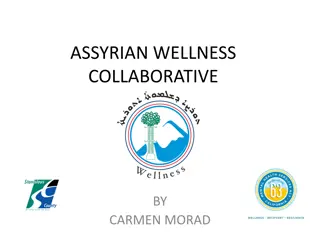
Follow-up Rates for Substance Use Disorder in ED Visits
Explore data on the percentage of ED visits related to substance use disorder and overdose that received follow-up care within 30 days. Discover insights on patient populations, age groups, gender, race, and regional variations in follow-up rates from 2022 to 2024.
Download Presentation

Please find below an Image/Link to download the presentation.
The content on the website is provided AS IS for your information and personal use only. It may not be sold, licensed, or shared on other websites without obtaining consent from the author. If you encounter any issues during the download, it is possible that the publisher has removed the file from their server.
You are allowed to download the files provided on this website for personal or commercial use, subject to the condition that they are used lawfully. All files are the property of their respective owners.
The content on the website is provided AS IS for your information and personal use only. It may not be sold, licensed, or shared on other websites without obtaining consent from the author.
E N D
Presentation Transcript
FUA The percentage of ED visits among members ages 13 years and older with a principal diagnosis of substance use disorder, or any diagnosis of overdose, for which there was follow-up within 30 days of the ED visit for 2022, 2023, and 2024. Seema Morad LSUHSC New Orleans, Population Health Management September 17, 2024
WHY? In 2022, 48.7 million Americans over 12 years of age were classified as having a SUD. Between 2018 and 2021, the use of ED services for substance use increased 39%, and the rate of ED visits related to substance use went up from 74.4 to 103.8 visits per 10,000 individuals. People leaving the ED after a high-risk substance use event need coordinated care because they might be at a higher risk of losing touch with the health care system
ACLA 30-Day Follow-up Annual Rates: 2022 - 2024 36.34% Data Set (General Overview) 29% 23% Total ED visits: 2022: 1,493 2023: 1,165 2024 YTD: 554 Followed up within 30 days: 2022: 433 (29%) 2023: 237 (20%) 2024 YTD: 127 (23%) 20% 2022 2023 2024 YTD FUA Rate Goal Except for one age group, the year 2023 consistently showed a drop in follow-up from 2022 for every factor.
Age Follow-Up Rate by Age 31% 28% 29% 22% 21% 19% 18% 16% Ages of Patient Population 212 595 97 Patient Number 2022 2023 2024 YTD 13 to 18 Y.O 19 to 40 Y.O 41+ Y.O 297 127 836 45 13 63 2022 2023 2024 YTD 13 to 18 Y.O 19 to 40 Y.O 41+ Y.O
Gender Follow-Up Rate by Gender 30% 29% 20% 19% Gender of Patient Population 348 737 949 Patient Number 2022 2023 2024 YTD 206 428 544 Female Male 2022 2023 2024 YTD F M
Race Follow-up Rate by Race 34% 32% 25% 22% 15% 14% Race of Patient Population Patient Number 757 554 2022 2023 2024 YTD Black or African American White 230 600 525 285 2022 2023 2024 YTD Black or African American White
Regional Data Patient Population by Region (2022-2024 Combined) 12% 23% 10% 14% 11% Region 1 Region 2 Region 3 Region 4 Region 5 Region 6 Region 7 Region 8 Region 9
Drastic Fall in 2023: every LDH region experienced drop in 2023. Suggests systemic or region-wide factors influenced follow-up: policy or funding changes, access to care issues, regional variability. Regional Recovery in 2024 for Regions 2, 3, 4, 5, and 9. Suggests successful regional interventions or a rebound in healthcare service provision in these areas. Consistent decline in Region 1: Jefferson Parish specifically dropped from 28% in 2022 to 6% in 2024. The steady patient proportion with declining follow-up rate indicates worsening engagement or access to follow-up care services. Small patient population in Region 8 makes follow-up rates sensitive to fluctuations. A few counties had very few patients completing follow-up in 2022, with many having 0 in 2023 and 2024, contributing to a dramatic drop in the region s overall follow-up rate. Follow-up by Region: 2022, 2023, & 2024 36% 34% 34% 33% 33% 30% 29% 29% 28% 27% 27% 26% 25% 24% 24% 23% 22% 22% 22% 20% 19% 19% 18% 16% 15% 13% 13% 2022 FUA 2023 FUA 2024 YTD FUA Rural 21% 22% 27% Urban 77% 77% 73% Region 1 Region 2 Region 3 Region 4 Region 5 Region 6 Region 7 Region 8 Region 9 2022 2023 2024 YTD
Administration of Pharmacotherapy within 15 days following ED visit Data collected includes drugs administered for opioid use disorder or alcohol use disorder, with much larger proportion of prescriptions for opioid-use Follow-up Based on Pharmacotherapy 97% 92% 86.44% Pharmacotherapy Population 1106 24% Patient Population 17% 18% 518 186 2022 2023 2024 YTD 59 51 36 No Drugs Pharmacotherapy 2022 2023 2024 YTD No Drugs Pharmacotherapy
Possible Benefits of Pharmacotherapy Increased Engagement in Care: acts as an entry point into more comprehensive care. Typically require ongoing monitoring for side effects and prescription management. Symptoms Management: reducing cravings/withdrawal improves patient s ability to participate in care. Patients less likely to relapse or miss appointments due to substance use or associated complications. Better Provider-Patient Relationships: creates trust and sense of accountability that encourages patients to adhere to follow-up schedules. Improved Outcomes & Quality of Life: patients experiencing benefits of pharmacotherapy (eg, reduced substance use) might be more inclined to continue with follow-up care to maintain these benefits.
Patients with Prior ED Visits from Previous Year Prior ED Visits 45% 40% 33% 31% 33% 28% 24% 22% Population of Prior ED Visitors 10% 5 42 Patient Number 3 31 2022 2023 2024 YTD 464 1 to 2 3 to 5 6+ 32 343 40 125 2022 2023 2024 YTD 1 to 2 Visits 3 to 5 Visits 6 Visits
More to Consider Targeted interventions for Adolescents: an age-appropriate follow-up program for patients aged 13-18, such as school-based services or family support programs. Address racial disparities: implement culturally tailored follow-up programs that address the specific needs of Black patients. Are patients of color experiencing worse patient interactions with providers compared to their White counterparts, leading to less desire to follow-up? Is there equitable access to follow-up care? Enhance Pharmacotherapy Access: Increase the early use of pharmacotherapy for patients with substance use disorder or overdose. Streamline the process for initiating pharmacotherapy before ED discharge to ensure higher engagement in follow-up care. Develop a high-risk registry for patients with recurrent ED visits: a dedicated care coordination team to provide follow-up support for patients with multiple ED visits.
References https://ldh.la/gov/assets/Medicaid/HEDIS/LA_MY2022_HEDIS_PM_R esults_AnalysisReport_F1.pdf https://www.louisiana-demographics.com/counties_by_population https://www.kff.org/statedata/mental-health-and-substance-use- state-fact-sheets/louisiana/ https://www.ncqa.org/hedis/measures/follow-up-after-emergency- department-visit-for-substance-use/


